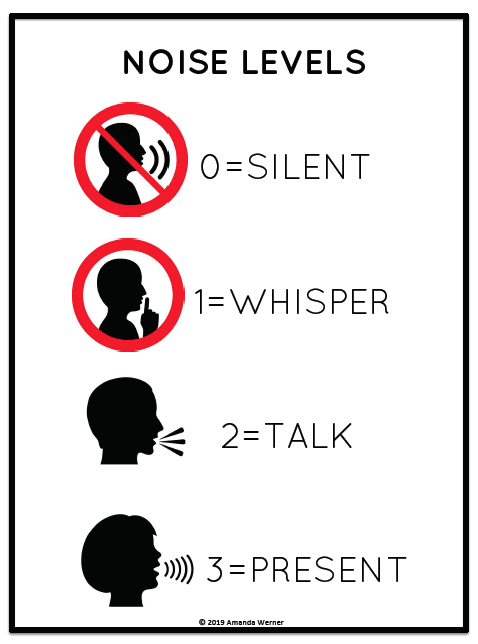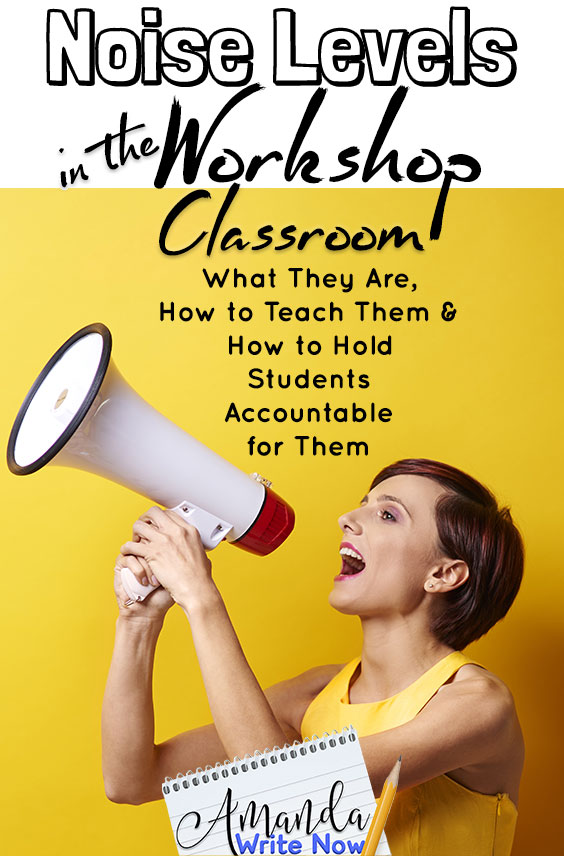
Kids love to talk to each other, they are human and humans are social! In a classroom of thirty plus secondary students how can we balance allowing that innate need to talk with maintaining a quiet, productive atmosphere? The answer: noise levels.
If you are a middle or high school teacher you may be thinking…this is way too elementary for my students. My response is…just give me a chance here:) If you go about teaching noise levels in a logical, respectful and caring way your students will buy in no matter how old they are.
Here is what you’ll learn in this article:
- What noise levels are
- How to teach them to big kids
- How to hold everyone accountable for them
What are Noise Levels?
Noise levels are different volumes in your class. I like to teach four noise levels.
- Silence
- Whisper
- Talking
- Presentation
How to Teach Noise Levels
Teach noise levels with this step by step process…
1. Use Logic & Facts
Ask students to fill out a Google Form survey with one question…
When you have to get some important writing/reading done for school that requires a lot of focus, how do you work best?
A . I need it to be pretty quiet.
B. I can tolerate a bit of noise.
C. I need background noise.
Your survey results will vary from class to class but it is pretty much guaranteed you will get some students who answer A, some who answer B and others that answer C.
Each student in your class has different needs when it comes to noise levels, therefore you need a system in place to meet the needs of everyone.
However, what if none of your students pick option A?
For a class like this (and all classes for that matter) you definitely will need to discuss the difference between chatting to get help and chatting to get off task.
If you allow students to chat while they work it will most definitely divert their attention from being productive when the work is independent and requires undivided attention, like reading or writing.
You can choose to show students the results of the survey or not. If you get results like what is shown in the image below, I would recommend you show students the results to prove that you need a system that incorporates a variety of noise levels to meet the variety of needs in your class.
If you get the results back and absolutely no one picked A it might be best not to show the results but rather just go straight into step two, explaining your noise level system below.

A Side Note About Listening to Music While Working:
A lot of students want to listen to music while they work. These might be the students who “need a little background noise”. I don’t have a problem with listening to music while students write as long as I see they are actually writing and being productive.
However, I don’t let students listen to music when they read. Reading and listening to song lyrics just doesn’t seem like a good idea to me. Reading takes a special kind of concentration in my opinion. Whereas, music might inspire students while they are trying to write. Again, this is all just one teacher’s opinion! I’d love to hear your thoughts on this issue in the comments below or join the Inspiration for Upper Grade Workshop Teachers Facebook Group and share your opinions there. We’d love to have you!
See the “Holding Students Accountable” section below about what to do if students aren’t working productively while they listen to their music.
2. Explain Your Noise Level System
Next, explain the noise level system…
Tell students that some days the work students do will require silence, other days it will require whispering and other days students will be able to talk. Show students the poster as support for teaching about the new noise level system in your class.
Explain that the noise levels for the day will depend on the type of work that students will be engaged in. See examples below.

3. Assign Noise Levels During Work Time
After you’ve explained the system every time you send your students off to write you’ll want to designate what the noise level is by telling and showing students. You can show the noise level by writing it down or placing a clip on the appropriate noise level on your noise level poster. You should announce the noise level each day too.
The noise level should depend on what stage in the writing process students are in and the type of work they will be engaged in. Here are different noise levels that correspond with different stages of the writing process.
- Whisper-Brainstorming
- Silence-Drafting
- Whisper-Conferencing
- Whisper-Revision
- Silence-Peer Editing
- Talking-Peer Feedback
- Presentation-Sharing Writing with the Class
- Talking-Publishing Party
4. Practice
Finally, practice noise levels daily at first then weekly and then monthly once students have it down. You may have to go back to weekly and even daily if students start to revert to their old ways of disregarding noise levels.
But how do you practice? Here’s one idea for how you could practice…
In the beginning you need to show students what each level actually sounds like. Point to the noise level and have student use that level.
So, if you point to silence on the poster then have students actually sit in silence. This may be uncomfortable at first but it is so important to show students you mean business! If students goof off or don’t take you seriously see the “Holding Students Accountable” section below.
Next, point to the whisper portion of your poster and have students practice whispering with their peers. Do this with the other levels on the poster until students are clear about your expectations when it comes to noise levels.
For the presentation voice level, make sure to get a few volunteers to practice speaking loud and clear in front of the class. You might want to get a few brave students to speak quietly in front of the class to show how frustrating it can be when you can’t hear a student’s presentation.
Yes, this may be basic. Yes this may be awkward. But, it’s important and it’s worth it! Sometimes the silliest and simplest things are the most valuable.
Holding Students Accountable
In order to have students follow through with noise levels you have to have some consequence system in place and you have to actually follow through with it too! Here’s an example consequence system you could use to hold students accountable.

Wrap Up
Teaching noise levels is vital! Students need clear expectations from you. They won’t usually outright tell you, but most students yearn for structure and tight systems so they can be productive and learn in your class.
So, what systems do you have in place to keep things productive in your class? Feel free to comment below…
Related Articles
5 Distracting Student Behaviors During Writing Workshop and What to Do About Them
The Beginner’s Guide to Writing Workshop
My Students Don’t Write During Writing




0 Comments